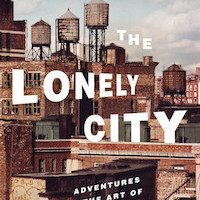It is probably safe to say that feeling lonely in a large city is not unique. And even though the feeling can sometimes devastate, a quick survey of our culture proves it’s easy to romanticize the phenomenon of urban wanderlust anchored by a kind of glamorous loneliness. Thankfully, Olivia Laing does not idealize this often ruinous sensation. Her third book, The Lonely City, sheds empathetic light on artists who struggled with loneliness in their respective metropolises. Laing uses research conducted in archives as well as drawing upon primary sources—her own loneliness—to explore the ways in which urban loneliness can manifest itself in dangerous, creative, sexual, virtual, and political ways. She acts as a kind of docent, interpreting the condition as it appears in visual contemporary art. By focusing primarily on four American artists—Edward Hopper, Andy Warhol, David Wojnarowicz, and Henry Darger—and contemplating theories proposed by both philosophers and social scientists, Laing reveals a condition that, although nearly universal, is not completely understood.
All of Laing’s subjects spent their lives on the periphery—of sexuality, culture, health, art, or identity in general. Most of the types of loneliness discussed bloomed from the extreme inequities these artists faced. There is Warhol, the homosexual immigrant; Darger the undiagnosed mentally ill man; Wojnarowicz the gay outcast, his stigma exponentially multiplied after contracting AIDS.
“In Loving Him,” Laing’s chapter on Wojnarowicz, is perhaps the most beautiful and the most heartbreaking. In it, she traces the photographer’s life from his bruised boyhood to his final days as a victim of AIDS shamed by the oppressive systems of the American government. Laing writes with a compassion and curiosity rarely seen in any genre:
One of David’s strongest memories of his street years was periodic nights of rage, in which he and a buddy would get so choked up with hunger and frustration that they’d walk almost the length of Manhattan island, smashing the glass in every phone box that they passed. Sometimes you can change the psychic space, the landscape of the emotions, by carrying out actions in the physical world. I suppose in a way that’s what art is, certainly the near-magical art that Wojnarowicz would soon begin to make, as he turned increasingly from destruction to creation.
By analyzing his wrenching images and actions, Laing shows how Wojnarowicz was able to channel a debilitating condition into something unquestioningly redemptive.
Yet, social theorists and artists alike have long compared loneliness to a disease, often, as Robert Weiss, wrote, “without redeeming features.” Laing devotes a section of The Lonely City exploring the idea of loneliness as a disease, a metaphor she calcifies with examples of artists affected by AIDS in the cultural apocalypse of ’80s New York. “The mechanism,” Laing writes, “is broadly the same as in loneliness itself—a decline in immune function due to ongoing exposure to the stress of being isolated or rejected.” Laing’s discoveries concerning the impact of loneliness and AIDS reveal the ways humanity can ignore or punish the pained and the power art possesses in its ability to connect various modes of isolation. Empathy, she finds, can also be contagious.

Laing’s intuitions and speculations are fueled by firsthand experience. The most relatable passages of The Lonely City are not when she’s diagnosing the artists using existing theories and scientific backing, but when she’s viewing the art and artists through the prism of her own loneliness. This is best exemplified in a chapter titled “Render Ghosts”—a kind of online travelogue that follows Laing as she treks through the “endless city” of the internet, examining the loneliness that comes with Twitter, Craigslist, and other websites. Instead of walking through the spaces of a physical city, it’s scrolling, clicking, and swiping that triggers a newer type of loneliness in the digital age, one that stems from a lack of likes or retweets, a dearth of followers. As Laing learns, the pain of virtual loneliness translates into the physical world, and “social” media does not hold its promise of providing intimacy or real relationships. The “miracle of laptops and smartphones is that they divorce contact from the physical, allowing people to remain sealed into a private bubble while they are nominally in public,” she writes, quickly admitting that “Everyone knows this. Everyone knows what it looks like.” She suggests, though, that our self-ostracism is not a product of our devices, but vice versa: “Part of the impetus for inventing as well as buying these things is that contact is difficult, frightening, sometimes intolerably dangerous.”
Toward the end of the book, Laing muses on the significance of stitching, specifically in the work Strange Fruit, a biodegradable art installation comprised of sewn-together fruit rinds and skins—bananas, oranges, grapefruit, lemons—by Zoe Leonard. As Laing explains, Leonard created the piece in tribute to victims of AIDS, specifically Wojnarowicz. An attempt to heal, to salvage. What makes Strange Fruit “so deeply touching, so intensely painful,” Laing writes,
is the work of stitching, which makes legible another aspect of loneliness: its endless agonizing hope. Loneliness as a desire for closeness, for joining up, joining in, joining together, for gathering what has otherwise been sundered, abandoned, broken or left in isolation. Loneliness as a longing for integration, for a sense of feeling whole.
Laing then considers the stitching prevalent in her case studies—the famous self-portrait of Wojnarowicz’s sutured lips, a metaphor for a silenced community; the corset that kept Warhol together after he was shot, a symbol of his fractured identities. This fascination with “threading things together” is perhaps primarily embodied in The Lonely City itself. Laing’s book too is a poetic and political act of stitching together, a patchwork of different genres that include biography, criticism, essay, and memoir. Like Leonard’s piece, loneliness has the capacity to empty, to reduce a body to a withering husk. People answer this reality in any way they can, by stitching themselves together with art, drugs, sex, kindness, or violence. But “Strange Fruit” asks an unnerving question: does loneliness nourish or consume you? Laing would probably answer “both”.
The book’s subtitle—“Adventures in the Art of Being Alone”—is slightly misleading and much too cheery, but it signals toward what Laing is getting at. Even if being alone does not qualify as an art form, Hopper’s mysterious portraits of loneliness would never had existed if it weren’t for his complex feelings of isolation. We would be without Warhol’s masterpieces and Wojnarowicz’s meaningful documents of detachment if somehow their destinies had realigned, free of loneliness. Loneliness, Laing finds, must not end in itself. Let it instead be a prerequisite for something more.
There are few certain declarations in The Lonely City, and this is to its benefit. Laing is careful not to come to any simple conclusions, instead using her research and experiences to offer insights and possibilities. Although I read The Lonely City in the same urban spaces that usually impart a familiar loneliness—loud cafés, quiet apartments and slow trains choked with strangers—I felt different while reading it. Discovering the complex forms of loneliness that gripped all of these people, something surprising happened, something Laing most likely intended. It made me feel, for at least a little while, a bit less lonely.




